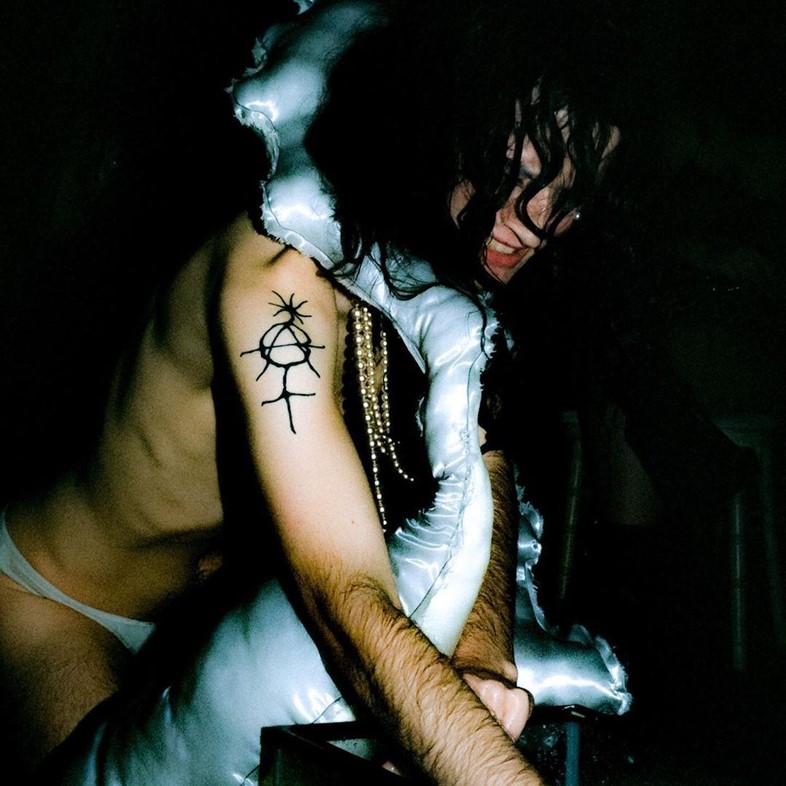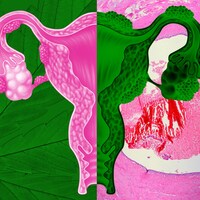A defiant and transgressive act against the status quo, crude DIY tattoos have been taken up by the queer community as a proud symbol of their outsider status
Brandon has a large tattoo on their left calf. According to them, it symbolises three things – “riot weapon, kink medium and a survival tool”. To the unassuming eye, it’s a giant bottle of piss.
Brandon is a gender-fluid illustrator based in London, and their tattoo is part of a wider trend. All over the UK, queer people are picking up stick-and-poke needles and tattoo machines, using them on their friends, then going professional. The tattoos they’re making are crudely drawn, usually have little-to-no shading or colour, and often seek to shock. Dubbed ‘deliberately bad’ by some, these DIY tattoos have a name – ignorant style.
To the queer people who have them, ignorant-style tattoos are a defiant act against the status quo and a statement against cisnormative dogma. While tattoos have often been positioned as a life-changing decision and, therefore, requiring deeper meanings and allegorical symbols, many trans and non-binary people have already made permanent changes to their bodies, already feel like outsiders, so what difference is a silly tattoo going to make?
“I can see people falling into the trap of thinking ignorant style is just being shitty at tattooing,” says Delia, the transgender tattoo artist behind Brandon’s piss-bottle body art. “I’ve always loved irregularities and mistakes. I realised my life is just a long series of mistakes and I’ve had to figure out how to hold those mistakes with tenderness and make them a part of something, rather than a feature that’s unwanted.”
Delia tattoos in character as ‘Diny’, a twisted and childlike alter-ego whose fixations include anti-capitalism and dead animals. Her designs are messy, chaotic and regularly explicit – one tattoo depicts a tyrannosaurus rex with an erect penis. Another shows two flies having sex, doggy style. She sees these more controversial designs as a way for queer people to reclaim their outsider status in a world where counterculture has become culture, and tattoos in general are no longer taboo. “If you still want to make people feel affronted,” she says, “then you’ve got to move into tattoos looking purposefully bad”.
Practicing what she preaches, Delia sports equally explicit work on her own body as the designs she gives her clients. One particular neck tattoo, which depicts a cat holding a knife while urinating and defecating, recently caused offence to a passer-by. “The person was like ‘Why have you got a fucking monkey tattooed on your neck?’ and I was like ‘It’s not a monkey – it’s a cat. It’s shitting and pissing and it’s going to stab you’”.
For some people this kind of attention means they are doing something right. 23-year-old queer sex shop worker Colette, who is covered in ignorant style tattoos, says stares from cis-het people on the street are “the highest form of compliment”. “I feel that the ignorant style is almost anarchistic,” they say. “It defies the gentrified tattoo style and embodies self-expression beyond what regular tattoo artists can offer.”
Most of Colette’s tattoos are the work of Lewis, a Glasgow-based, non-binary artist whose uncanny style incorporates monsters, scary clowns and reclaimed words and phrases like ‘f*ggot’ or ‘I’m gay as fuck’. Lewis says that queer people often opt for the DIY tattoo experience because the mainstream route doesn’t accommodate them. “A lot of queer artists work from their homes or private studios, which is safer for people to whom rooms full of straight male artists are a bit daunting. Tattooing can be really painful, so if it’s done in a space where you feel comfortable, then it’s a nicer experience.”
Despite this focus on accessibility, Delia still points to gender imbalances even within the queer tattooing scene, characterising it as dominated by trans-masculine people. “Where the fuck are the trans women?” she asks. “We’re out there tattooing all over the world, but most of the time we’re doing so out of our houses. And it’s for the same reason we’re excluded from loads of other things – people know we’re the ones most likely to cause problems.”
One trans woman who has recently moved into tattooing is performance artist Joni, who shares her combined home and workspace with fellow queer artist Jetsün, having learned her craft from him. Archival trans and anarchist posters and magazines serve as a key inspiration for Joni’s ‘tranarchistic’ work, and her most-requested design is an emblem that she describes as “a visual portmanteau of the trans and anarchist symbols”.
For Joni, the transgender experience underscores not only the content of her art but also the way it’s made, with most of her clients being other trans people. “My studio is my living room, in my all-trans home, and that bed you’re lying on is kindly shared by the other trans artists who live there. All my work, tattooing and otherwise, feels entirely reliant on t4t connection and care.”
Joni traces and then re-traces her designs without a machine, which results in no two tattoos looking the same, even when they’re based on the same flash piece. In her view, it is this methodology that makes her tattoos ‘ignorant’. “They never look ‘how they should,’” she explains, “just as the bodies they’re imprinted upon defy expectation and homogeneity.”
Jetsün also sees a link between queer bodies and the uninhibited creativity associated with ignorant tattoos. “Queer people tend to be really in touch with our trauma,” he says. “With tattoos, you’re making a permanent decision – and I believe, whether consciously or not, you’re deciding to embrace your body by being creative with it.”
20-year-old musician Link first started getting DIY tattoos at 15, and for them they’re inextricably linked to their relationship with their body. The way they see it, “my body is already taboo, so I may as well have fun with it”. Link’s tattoos include a marijuana leaf, the words ‘piss’ and ‘wasteman’, and the National Rail logo. He says that cis people are often preoccupied with whether he’ll regret these when he’s older, and compares this to the questions often posed about medical transition. As he plainly puts it: “If I don’t regret getting ‘piss’ on my arm, then I’m not going to regret going on hormones or getting top surgery.”
These concerns about ignorant style tattoos’ permanence speak to cisnormative anxieties around anything that breaks the mould. But by now, the cycle of respectability has been well-rehearsed – it feels obvious that over time, attitudes will erode. It’s no surprise that queer people sit front-and-centre of this movement, just as we’re always driving cultural change. In years to come, contestants on Love Island will probably be ignorantly inked, and it will be queer people they’ll have to thank.










